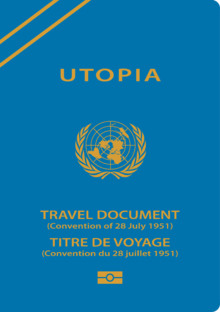


A refugee travel document (also called a 1951 Convention travel document or Geneva passport) is a travel document issued to a refugee by the state which they normally reside in, allowing them to travel outside that state and to return there. Refugees are unlikely to be able to obtain passports from their state of nationality (from which they have sought asylum) and therefore need travel documents so that they might engage in international travel.
The 145 states which are parties to the 1951 Convention Relating to the Status of Refugees are obliged to issue travel documents to refugees lawfully resident in their territory.[1]
Refugee travel documents are passport-like booklets. Their cover bears the words "Travel Document" in English and French (and often in the language of the issuing state), as well as the date of the convention: 28 July 1951. The documents were originally grey, though some countries now issue them in other colours, with two diagonal lines in the upper left corner of the front cover. Bearers enjoy certain visa-free travel privileges extended by signatories to the convention.
However, as a refugee travel document is not a regular national passport, some problems may be encountered by the holder from time to time, for example due to non-familiarity of airline staff with such documents.[2][3][4]